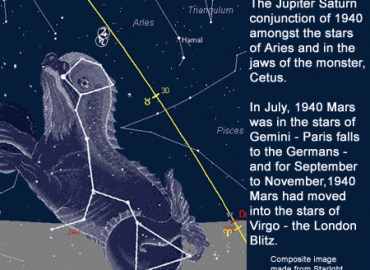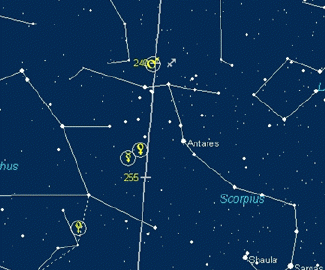Bernadette Brady
April 2006

In the Babylonian pantheon, Nergal was the god of war and he was always shown as bearded and carrying swords or weapons. Through his love for Ereshkigal, he also became the god of the Underworld. He ruled over all battles, as well as the cemeteries of warriors, and he could bring plague to live stock, particularly cattle. When the Greeks took dominancy around 600 B.C.E. then his warrior features were absorbed and translated into the Greek hero Hercules, as well as the Greek god of war Mars and, through his association with Mars, Nergal gained rulership over the zodiac signs Aries and Scorpio. But in this Greek translation Nergal lost his authority as Lord of the Underworld as that position was assigned to Zeus’ brother Hades. However, two and a half thousand years later, when Pluto was discovered in 1929 and named after the Roman god of the Underworld, Nergal regained some of his rulership of this domain when astrologers assigned Pluto rulership over Scorpio.
The Mesopotamian Nergal
As the god of the Underworld and the god of war, Nergal’s activities were closely watched by the Babylonian priests. Features such as colour changes, brightness and of course conjunctions with other planets were meticulously monitored. But when the Babylonian priests wrote of Mars forming a conjunction, there was always an element of doubt or a direct statement that Mars will not actually make the conjunction.
These are words concerning Akkad. [the kingdom]
Mars remained four fingers distant from Sat-
urn, it did not come close. It did not reach it[1]
In our astrology, Mars will always reach Saturn. There is no question about if the planets will form a conjunction and not even a question about when the planet will form a conjunction. Indeed there is a Saturn-Mars conjunction this year on 19June, 2006. So what does this priest mean when he says, that Nergal will not reach Saturn?
The Visual Behaviour of the Planets – different information
If you watch the sky over the next month, you will see that in the early evening light Mars is in the western sky with Saturn a little higher in the heavens. At the moment there is still – visually – a good distance between the two planets but this night sky would have been alarming to the Babylonian sky watching priest. Such a forthcoming conjunction would normally indicate the death of the King.
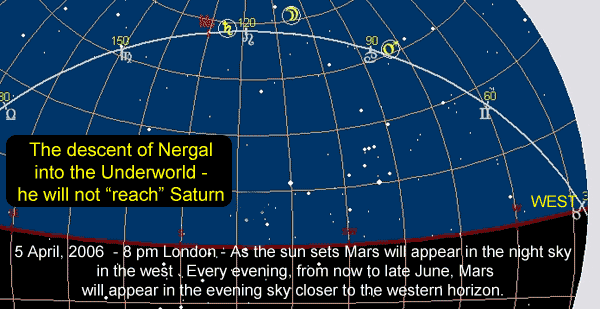
Now if you are watching the sky regularly, you will notice that, over the next few months, Nergal/Mars will be located lower and lower in the western sky at sunset. He is descending to the Underworld. This descent is part of a broader rhythm. When Nergal disappears by setting with the setting sun, he can be absent for many months because Mars can be travelling at the same speed as the sun and thus slow to get away from its light. However, if he sets with the rising sun, he is absent for just a few days before we begin to see him rising just after sunset. At the moment he is descending and he will slip from view by setting with the setting sun about June, July, 2006, (depending on your view of the horizon) and we will not get a clear sight of Mars again until May, June or July 2007, once again depending on your latitude.
Consequently he will probably not be seen to reach the conjunction with Saturn, as by the time the conjunction occurs, the two planets will be so low on the western horizon at sunset that, for most of us, they will have disappeared. When this occurred, the Babylon priest considered there was no threat to the king. I am not too sure if I agree with the Babylonians on this point. However, once we start to observe the visual behaviour of Mars, something quite interesting unfolds. Mars, or rather Nergal, since we are working with the planet’s visual behaviour, is actually now in the process of descending into the Underworld to join his lover, Ereshkigal, and in this instance it is going to be a particularly long visit.
Nergal’s Mesopotamian Mythology
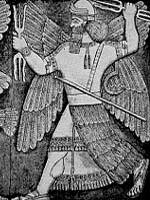
Ereshkigal is the elder sister of Inanna and she represents the dark, chaotic side of the feminine. As an intense and passionate lover, she demands Nergal’s sexual attention and he delights in returning her passion. In the great myth of their meeting – the earliest records date from the fifteenth or fourteenth century B.C.E. – Nergal visits Ereshkigal in the Underworld and although he is told to resist her and eat no food and drink no wine, she seduces him and they spend six passionate days together. Nergal then tells Ereshkigal that he must climb through the gates of the Anu, Ellil and Ea and return to the heavens. (The gates of which Nergal speaks are the names of the three pathways where the horizon cuts the sky. They are north of the ecliptic, the zone of the ecliptic and south of the ecliptic respectively.)
Nergal came up along the long stairway of heaven.
When he arrived at the gate of Anu, Ellil, and Ea,
Anu, Ellil, and Ea saw him and said,
“The son of Ishtar has come back to us,
She (Ereshkigal) will search for him and .
Ea his father must sprinkle him with spring water, and bareheaded,
Blinking and cringing let him sit in the assembly of the gods.
So Nergal is seen to rise in the predawn light. The gods rejoice at his arrival into the night sky and seek to disguise him as a simple man amongst the other gods to hide him from Ereshkigal. But she goes wild with sexual frustration yelling out:
Erre (Nergal), the lover of my delight-
I did not have enough delight with him before he left!
Erra, the love of my delight-
I did not have enough delight with him before he left.She then threatens the gods of heavens in her anger and says… According to the rites of Erkalla and the great Earth
I shall raise up the dead, and they will eat the living.
I shall make the dead outnumber the living!Above – this image is known as the “Queen of the Night”
and is believed to be of Ereshkigal
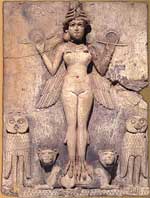
The myth then talks of how Nergal begins his slow descent once again into the Underworld but this time he has to kill seven gate keepers,Nergal went down the long stairway of heaven.
When he arrived at the gate of Ereshkigal he said,
“Gatekeeper, open !” … and after passing through seven gates he…He entered her wide courtyard,
And went up to her and laughed.
He seized her by her hairdo,
And pulled her from the throne.
He seized her by her tresses
The two embraced each other
And went passionately to bed [2]
There are, as you have probably already noticed, striking similarities with the Greek myth of Kore (Persephone). She is kidnapped and raped by Hades (Pluto), the god of the Underworldd. Her mother, Demeter, protests and causes life to come to a standstill. This action forces Hades to return Kore to the world. But Hades tricks her into eating six pomegranate seeds, thereby insuring that she will always return to him. These parallels are so strong that one senses that the Greek myth is a male rewrite of the older Mesopotamianstory of Nergal and Ereshkigal.
Nergal – a different Mars
There are several points to consider in this Mesopotamian view of Mars. In this myth, Nergal descends into the Underworld in the same manner as we think of Kore/Ishtar/Inana (Venus) in her descent. However, unlike the Greek myths, Nergal’s story is not one of rape and kidnap but of mutual love and a deep, intense, sexual passion. The relationship between Nergal and Ereshkigal becomes monogamous and unlike Hercules and Mars, his Greek/Roman counter-parts, Nergal never takes another lover. The myth ends with the two rulers of the Underworld living happily ever after.
So when Nergal is in the heavens, he is shown in the myth to be milder, calmer, fitting in with the other gods. When he is absent and in the Underworld, he is violent (the gate keepers are killed) as well as highly-focused, motivated and extremely aroused and passionate. So we see that Nergal has two sides and that these sides may be indicated by Nergal’s relationship to the sun.
Think about your own chart. Is your natal Nergal (Mars) in the Underworld with his lover or is he in the heavens with the gods? If you are born with a Sun-Mars conjunction with either the Sun approaching the Mars by only about 8 degrees or separating from the Mars by about 20 degrees (roughly), then your Mars is in the Underworld regardless of the zodiac signs involved. One would think that such a Mars would have a strong level of intensity in its actions, so I scanned a few files using Jigsaw to find charts with this Sun-Mars relationship and found the following list of people :
John Lennon (Sun 16 Libra, Mars 2 Virgo),
John Wilkes Booth (the man who assassinated Lincoln – Sun 19 Taurus, Mars 3 Taurus),
Sir Edmund Hillary (famous mountain who was the first to climb Mt Everest – Sun 25 Cancer, Mars 7 Cancer),
Vincent van Gogh (the Dutch painter – Sun 9 Aries, Mars 26 Pisces),
V.I.Lenin (Founder of the Russian communist movement. Sun 1 Taurus, Mars 22 Aries),
John F. Kennedy (Sun 7 Gemini, Mars 18 Taurus)
and finally…
Jimi Hendrix (Considered by many to be the greatest rock guitarist of all time, Sun 4 Sagittarius, Mars 17 Scorpio).
We will return to Nergal frequently in this newsletter, particular when he begins to re-climb the stairs back to the heavens early next year. I think that this ancient version of Mars, with his periods in the Underworld, his love, his passion and his equal relationship with his queen, Ereshkigal, is a more complete model of human love, sex and relationships than the rape of Persephone where the six days and nights of sexual passion are traded-in for six pomegranate seeds. I think that we have things to learn about Mars and his role in our modern charts from this Mesopotamian view of Nergal.
[1] Hunger, Herman. (1992). Astrological Reports to Assyrian Kings. Helsinki, Finland: Helsinki University Press. pg. 49
[2] Dalley, Stephanie. (2000). Myths from Mesopotamia. Oxford, UK: Oxford University Press



